
In a role as diverse and fast-pacing as marketing, project prioritization can mean the difference between a thriving career and a fledgling one.
As you know, having nice marketing ideas won’t suffice if you can’t weigh each marketing idea based on its short and long-term values.
But if determining what project should be put first has been a challenge for you, this piece is here to guide you step by step on project prioritization for marketers.
Get Your Priorities Straight With This Template
Prioritizing projects is easier when you have the right tools. Get started with this simple and easy-to-use project prioritization spreadsheet:
Why Project Prioritization is Important for Every Marketer
Marketing ideas are not in short circulation, but the ability to spot which of these ideas will bring the most impact is what makes you a genius.
Generally, you are either a marketer who commits to long-term gradual growth or a marketer who brings exponential growth and makes the impossible possible.
This is the kind of possibility Garret Moon is talking about in a piece about the 10x
marketing formula.
“It’s about achieving tenfold growth rather than incremental improvements,” he says. And that’s what your clients will use to judge you.
Yes, marketing should be all about meaningful impacts. It’s about scaling ten folds in a short time rather than growing 10% in a long time.
10% growth overtime is something nearly all marketers can pull off, but in reality, that’s not what businesses need these days.
With many competitors and copycats springing up every now and then, if you take too long before getting to the top, you’ll watch your prospects go to someone else.
Project prioritization is what will help you separate 10x projects from 10% projects.
But let’s put this in perspective even more.
Knowing Which Project Would be Most Impactful
No matter how great your team and budget are, you are still confined by time and resources.
When you first sit down to come up with marketing ideas, a lot of things will cross your mind but not all of them could be executed and, certainly, not all of them are of equal value to your goal.
Deciding on which marketing ideas should be executed requires thoroughness. But more than that, it requires a scientific approach. Or else you will waste your client’s money and time.
Having a project prioritization strategy in place is how you take the guesswork out of knowing which project will make the most impact on your business.
Getting Your Workflow Right
The path to delivering a successful marketing campaign is filled with frictions, and one way to reduce these frictions is to set up an excellent workflow.
Without knowing what comes first and what comes last, it’s impossible to put a workflow in place.
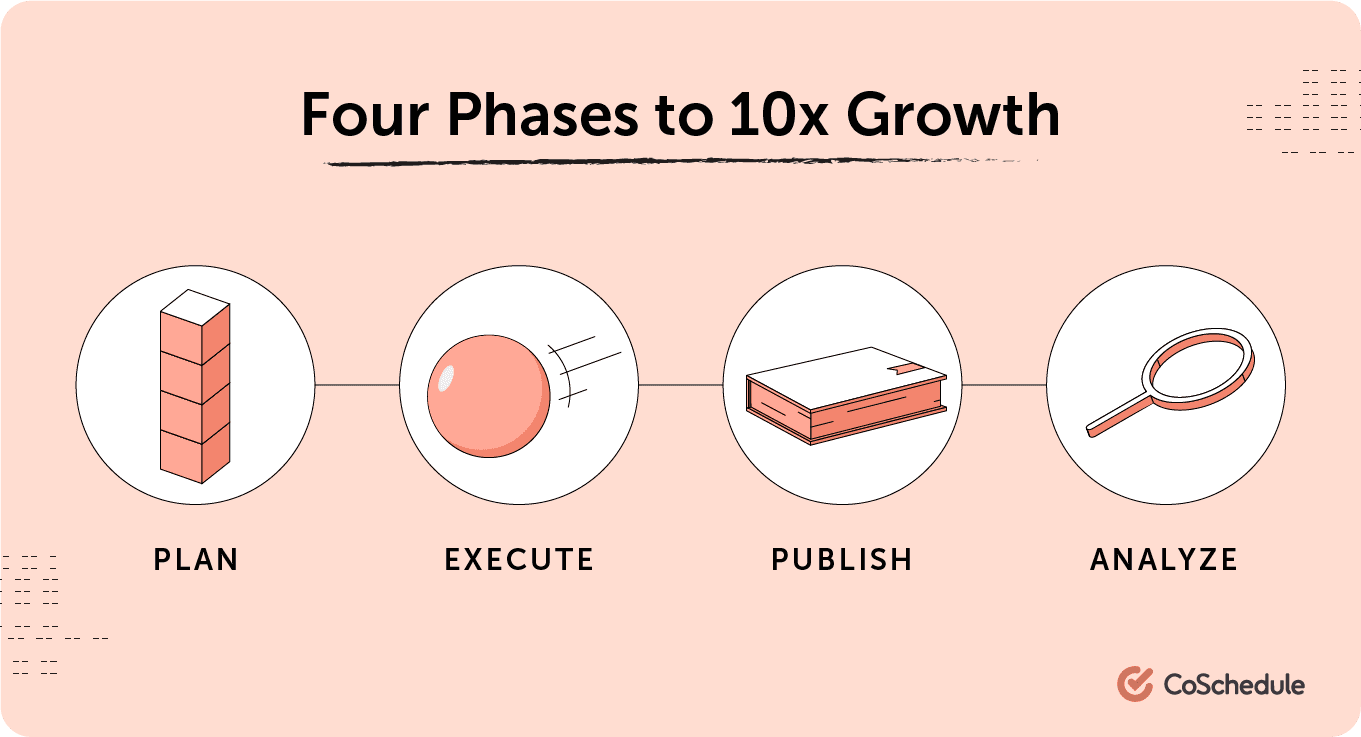
Of course, project prioritization in marketing means knowing what project to put first based on your goal and the resources available to you, which includes your team members.
If you want to bring your workflow alive, you need to know what your top priorities are.
What Are the Steps in Project Prioritization for Marketers?
In the marketing industry, you’ll see a lot of headlines like this:
“How we increased XYZ signups by 30% in three months.”
And they can be really tempting.
But what works for them won’t necessarily work for you the same way. That result they wrote about, they got it either through proper planning and prioritization or through sheer gut instinct, which is rarely the case.
We don’t know about the latter, but if you want to go by the former, here are the five steps you need to take.
Establish a Clear Business Goal
In different stages of business life, goals differ.
A new business is probably looking for signups, while a relatively old one may be trying to get its users to expand their accounts.
While they all want revenue and more of it, they sometimes have a means they need to reach before getting to the revenue end.
So, if you are brought in as a marketer to come and make a business goal attainable, the first step is to know what they are trying to achieve at that period in time.
This knowledge is necessary to set your creative instincts on the right course.
Whether they are going to need a top-of-the-funnel content strategy for lead generation or they just need a better in-app communication strategy to drive more feature adoption (in the case of a SaaS), establishing a business goal will give you direction.
And that’s the first thing you should do.
Brainstorm and Make a List of Ideas
Marketing ideas are not in short circulation, but not every one of them is going to help you. This is why you must sit down and brainstorm ideas to search for what might help you deliver in your current role.
The first step in choosing a very impactful project is having your ideas listed and reviewing them one after the other, making a gross calculation of their outcome, and then narrowing them down to the most viable ones on the basis of what you have to achieve within a specific period.
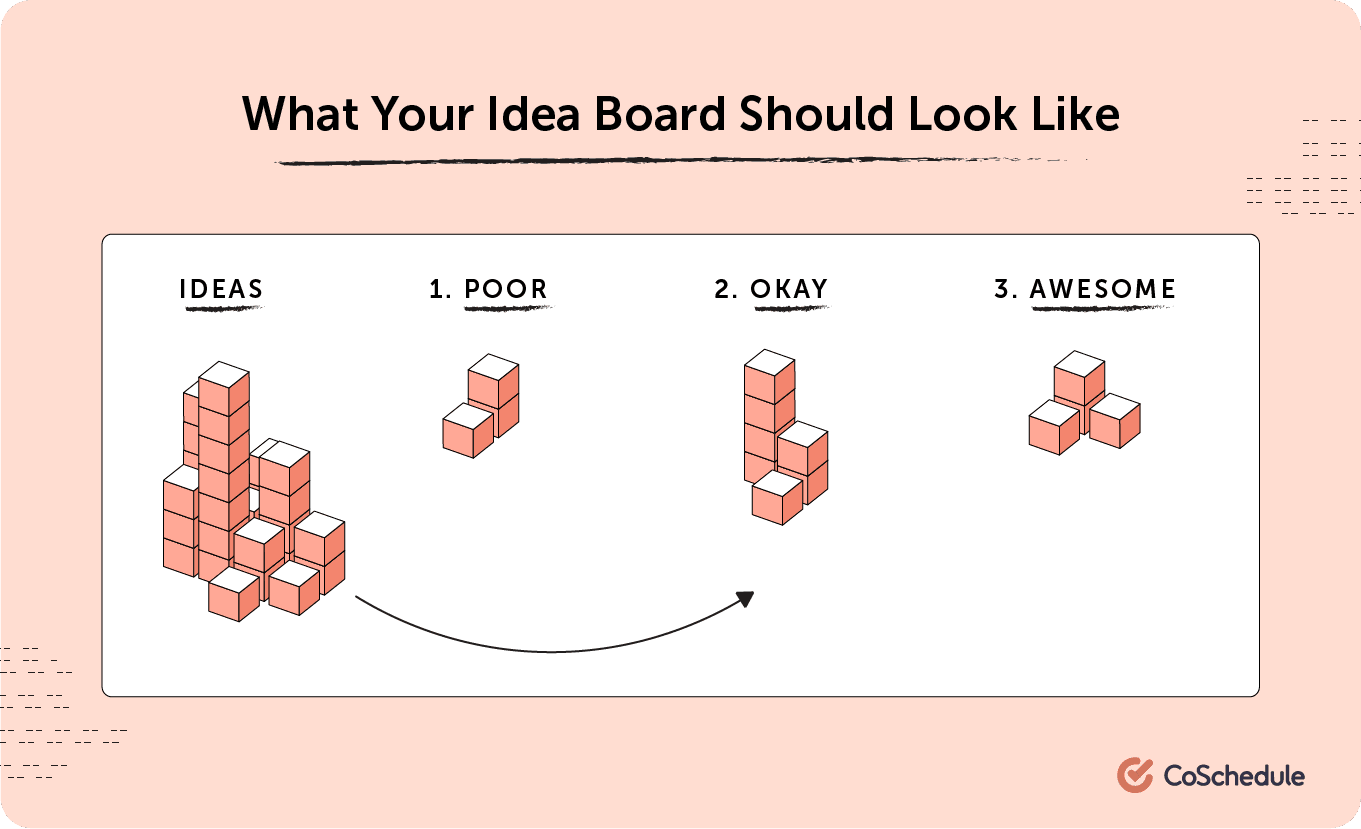
If you don’t know how to go about brainstorming and selecting the most viable ideas, you may find this
CoSchedule marketing brainstorming process very helpful.
Resources Assessment
Resources assessment is where you discern ridiculous business goals from feasible ones, and also determine which projects should take precedence based on available resources.
For any marketing goal to become attainable, there has to be a certain amount of resources in terms of team members, available information, funding, tools, and so on.
There will be other things as well, depending on your verticals. But if I’m going to be making resources assessment, I’ll typically consider:
- Number of team members available
- Time availability of the team members
- Skill levels
- How long the project would require to complete
- Budget
- The potential impact of the project
As you can see, you can’t do away with any of these if you are going to run a successful marketing campaign.
And in the course of setting priorities and deciding which project is worth putting first, taking inventory of available resources will be of great help.
Rate the Potential Impact of Each Project in Relation to Available Resources
Understanding the business goal, knowing what you want to achieve, and auditing your resources can only take you so far.
All these are an exercise in futility unless you can calculate the outcome of each project based on the cost and the time of that project vs. your ultimate goals.
So, how do you weigh the time and cost of each project vs. its predicted results?
Use what is known as a weighted decision matrix.
A weighted decision matrix is one of the two matrices used in deciding which options should be put first if you have many options to choose from.
Here is how to use a weighted decision matrix to know which marketing project you should put first at a given time:
List Your Options as Rows
When confronted with many projects to work on and unsure which one should take priority, the first step is to list those projects in a row.
For example, if I’m working in a SaaS company as head of marketing and I have a revenue mark I need to hit within a particular period, I may have something like this:
- Run a retargeting ad
- Host an ABM event
- Start a drip campaign
These three are my marketing ideas for this revenue target, but I need to figure out which one should take priority by placing it side by side with influencing factors.
Determine the Influencing Criteria/Factors
The influencing factors in making your choice can be anything, e.g. cost, ROI, effort, time, etc.
In my case, more revenue (ROI) is the most important factor at the moment because my goal is to hit a specific revenue mark. I will take cost as the second most crucial factor, and then time (how long each of these options would take) is also very important.
The next thing is to score these criteria using numbers 1-5 usually depending on how important they are to your project. This means 1 stands for the least important criterion, 2 stands for the next less important, and then 5 stands for the most important factor.
On a list of 1 to 5, which one has more weight among these factors for your project?
For me, I’d say:
ROI: 5
Cost: 3
Time: 5 (Remember, the numbers don’t have to be different. If all of them are equally important, put the same number there)
Here is an example:
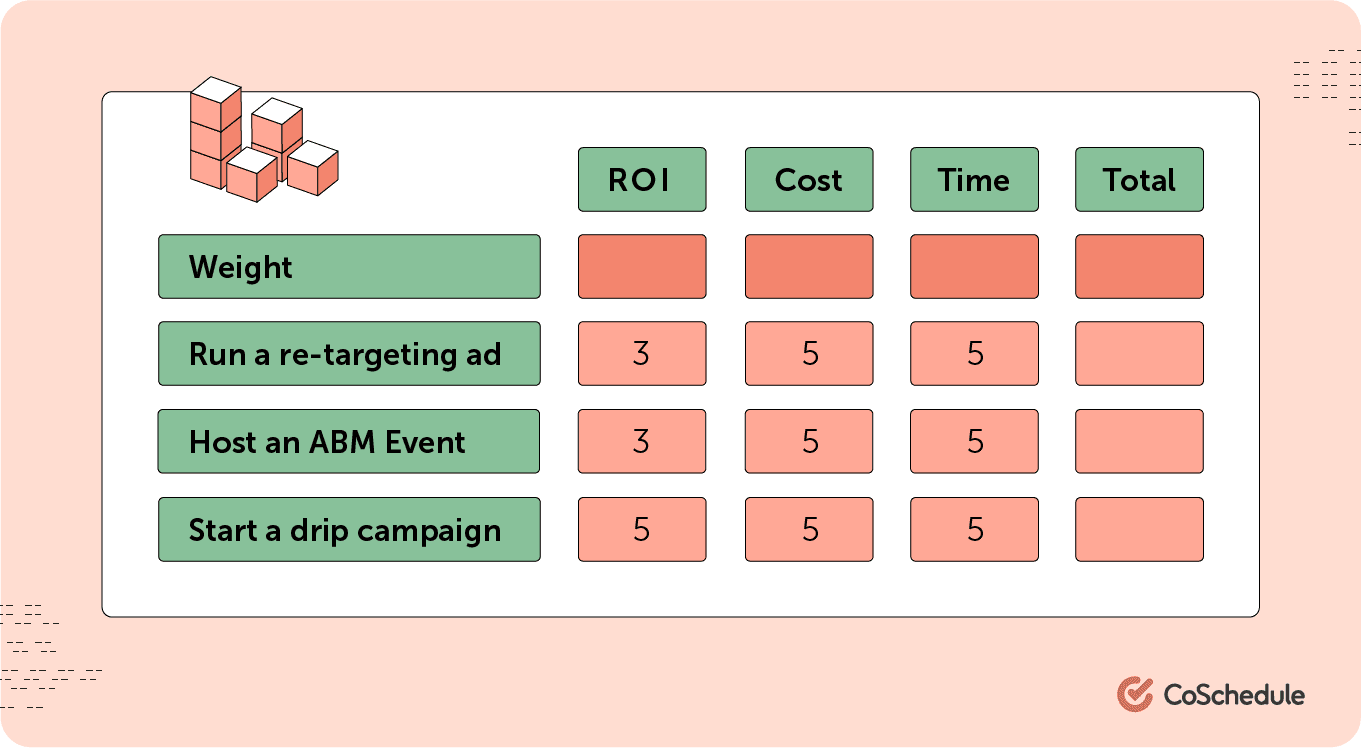
Assign a Weight to Each Criterion
Remember you assigned some weight to your options? Now you need to do the same to the factors as well.
Assign a weight to each criterion using numbers to define their significance and impact on your decision, on the scale of 1-5 as we did with the options, or more numbers depending on how many factors you have to take into consideration.
Here is an example:
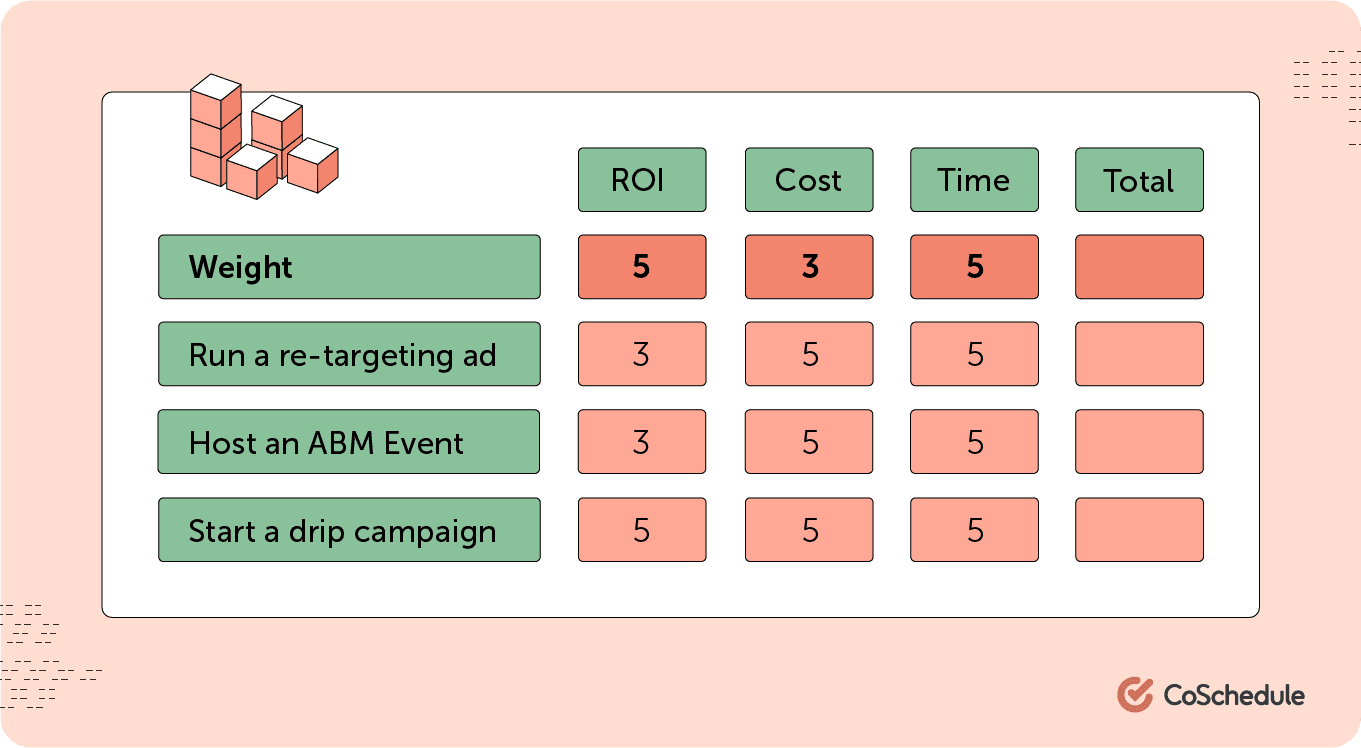 Now, multiply the number of each factor by the number of the criterion you are weighing them against and then total these numbers.
Now, multiply the number of each factor by the number of the criterion you are weighing them against and then total these numbers.
Like this:
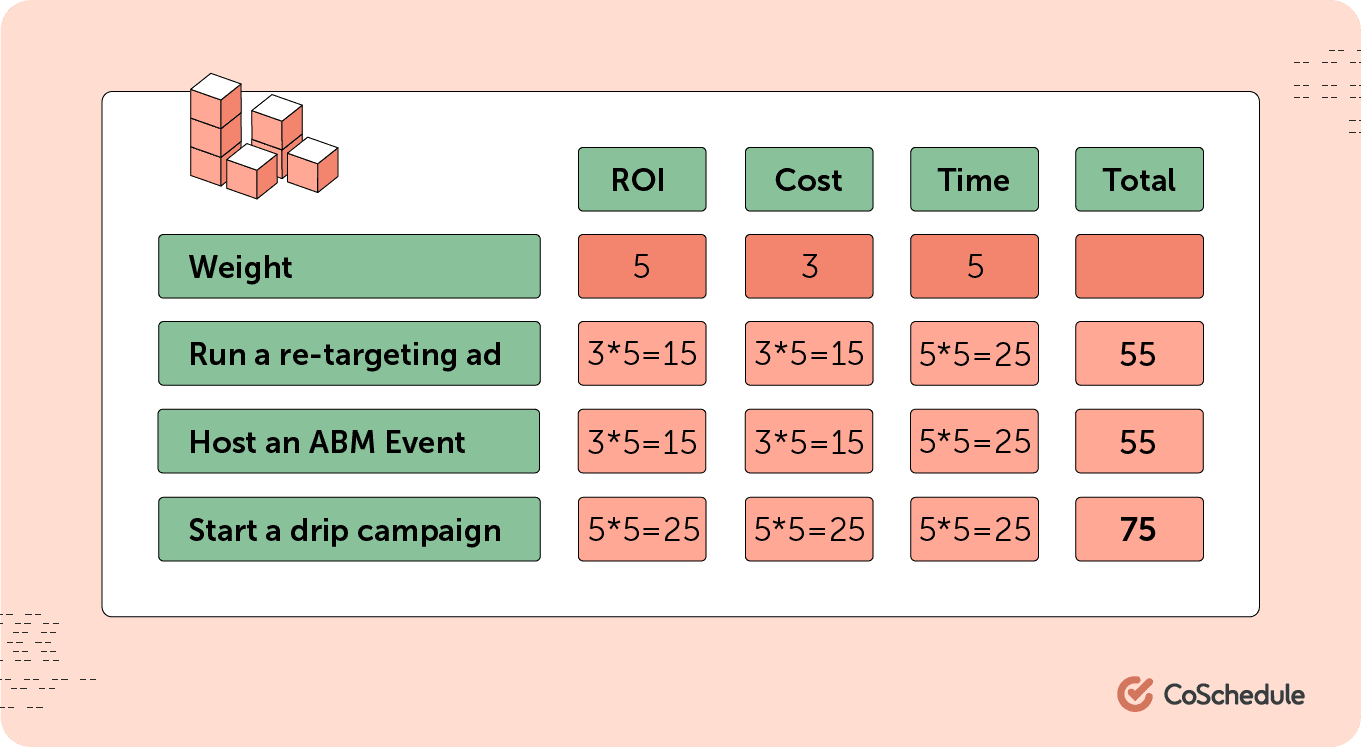 Which of these weigh the most? Drip campaign. That’s the most important project to me at the moment as it delivers the most value in terms of its ROI, the cost, and the time it would take me to deliver it.
Which of these weigh the most? Drip campaign. That’s the most important project to me at the moment as it delivers the most value in terms of its ROI, the cost, and the time it would take me to deliver it.
Create a Clearly Defined Workflow
You are adopting marketing project prioritization because you want to be able to deliver results and do it fast.
You can’t achieve that alone, and you can’t achieve it if you are not organized. That’s where workflow comes in.
Success comes as a result of teamwork, and for teamwork to be meaningful, you have to put each team member where they belong, set a timeline for each task, and define how everything flows from the beginning to the end.
I like what Kfir Pravda said about this:

And yes, that’s what you get when you have a marketing workflow in place. Remember you did a resources assessment earlier and your team members are part of your resources?
Now, it’s time to channel that knowledge into ease of operation by bringing them into a workflow, and then turn the valve to kickstart the process.
This will help you see clearly how much work you could do within a specific period. That way you can plan ahead on how to scale your efforts and make things better in the future.
Wrapping Up Project Prioritization for Marketers
If you talk about skills, there are skilled marketers everywhere. The ability to identify what project will bring the most benefit is what sometimes makes a marketer stand out.
Remember, marketers are not rated by how much work they have done but how much impact they are able to make.
If you find yourself overwhelmed by endless options of marketing ideas and need to choose the one that brings in the best results, use the five steps in this piece as a scale by which you weigh them. In a role as diverse and fast-pacing as marketing, project prioritization can mean the difference between a thriving career and a fledgling one.
As you know, having nice marketing ideas won’t suffice if you can’t weigh each marketing idea based on its short and long-term values.
But if determining what project should be put first has been a challenge for you, this piece is here to guide you step by step on project prioritization for marketers.
In a role as diverse and fast-pacing as marketing, project prioritization can mean the difference between a thriving career and a fledgling one.
As you know, having nice marketing ideas won’t suffice if you can’t weigh each marketing idea based on its short and long-term values.
But if determining what project should be put first has been a challenge for you, this piece is here to guide you step by step on project prioritization for marketers.
 Of course, project prioritization in marketing means knowing what project to put first based on your goal and the resources available to you, which includes your team members.
If you want to bring your workflow alive, you need to know what your top priorities are.
Of course, project prioritization in marketing means knowing what project to put first based on your goal and the resources available to you, which includes your team members.
If you want to bring your workflow alive, you need to know what your top priorities are.
 If you don’t know how to go about brainstorming and selecting the most viable ideas, you may find this CoSchedule marketing brainstorming process very helpful.
If you don’t know how to go about brainstorming and selecting the most viable ideas, you may find this CoSchedule marketing brainstorming process very helpful.

 Now, multiply the number of each factor by the number of the criterion you are weighing them against and then total these numbers.
Like this:
Now, multiply the number of each factor by the number of the criterion you are weighing them against and then total these numbers.
Like this: Which of these weigh the most? Drip campaign. That’s the most important project to me at the moment as it delivers the most value in terms of its ROI, the cost, and the time it would take me to deliver it.
Which of these weigh the most? Drip campaign. That’s the most important project to me at the moment as it delivers the most value in terms of its ROI, the cost, and the time it would take me to deliver it.
 And yes, that’s what you get when you have a marketing workflow in place. Remember you did a resources assessment earlier and your team members are part of your resources?
Now, it’s time to channel that knowledge into ease of operation by bringing them into a workflow, and then turn the valve to kickstart the process.
This will help you see clearly how much work you could do within a specific period. That way you can plan ahead on how to scale your efforts and make things better in the future.
And yes, that’s what you get when you have a marketing workflow in place. Remember you did a resources assessment earlier and your team members are part of your resources?
Now, it’s time to channel that knowledge into ease of operation by bringing them into a workflow, and then turn the valve to kickstart the process.
This will help you see clearly how much work you could do within a specific period. That way you can plan ahead on how to scale your efforts and make things better in the future.


